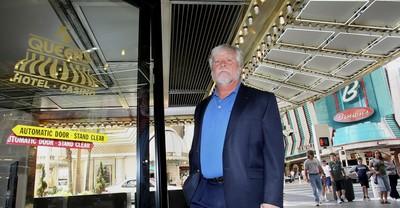Binion’s gets new boss

The owner of the Four Queens is planning to buy Binion’s for $32 million, stirring hopes that local control will revive the folksy charm and gambling allure Benny Binion used to make the property famous.
The current owner, MTR Gaming of Chester, W.Va., announced the deal with Four Queens owner Terry Caudill on Wednesday.
Whether Caudill, who owns the Four Queens, can restore the 56-year-old Fremont Street casino to its former glory remains to be seen. But news of the deal stoked hope a local owner can do more to restore luster to Binion’s than the West Virginia company that has owned the languishing casino since 2004.
Caudill, 59, said he intends to keep a closer eye on the property than MTR, which was more invested in race tracks and slots back East than it was in downtown Las Vegas.
“I can tell you it is very difficult to run a downtown property from across the country,” said Caudill, whose Four Queens is located diagonally across Casino Center Boulevard from Binion’s. “It is important to the customers to feel like there is an owner present.”
Steven Overly, vice president of business and legal affairs for MTR, declined to comment on the sale. Stock analysts praised the deal because Binion’s had been a drag on the company’s earnings since it bought the property from Harrah’s for $20 million.
Both Caudill and MTR said Binion’s would retain its approximately 850 employees.
“I’m just glad it is (Caudill) and not an investment company that doesn’t know anything and is just trying to make a buck,” said Bill Robinson, chief operating officer of the casino. “It finally looks like there is going to be some stability here.”
The sale still needs regulatory approval, which could take months. But Caudill already has plans to renovate the casino and its 366 hotel rooms within a year without closing the property.
“There hasn’t been the money spent that needs to be spent to keep the public areas looking fresh and clean,” he said.
Short-term upgrades will include new slot machines, improvements to public space in the casino, and drapes, carpet and furniture in the rooms. Caudill also said he is researching more extensive, long-term changes but is not ready to detail any plans.
Caudill’s most important contribution could be a regular presence on the property, which has been plagued by Binion family drama, regulatory scrutiny, ownership changes and financial losses since Jack Binion, son of bootlegging gambler and founder Benny Binion, relinquished control of the property in 1998.
“As an owner maybe you are going to see things others don’t see,” said Caudill, who controls TLC Casino Enterprises, the company that will own Binion’s if the sale is approved. “You see duct tape on the carpet and you have to explain to people that is not acceptable.”
In Binion’s, Caudill will get one of the most legendary casinos in Las Vegas that still benefits from its connection to the Binion family. The history includes Benny Binion’s reputation for good deals and hospitality as well as his notoriety for punishing cheaters and others who challenged him.
In addition to its reputation for taking any bet, no matter how large, Binion’s was known for its $2 steak dinners and a display of $1 million in cash that attracted countless gawking tourists.
“One or two things like that would get people remembering the way things used to be down there,” said Anthony Curtis, publisher of the Las Vegas Advisor. “They should drop the prices a little bit there and make it a place people go to hang out downtown. That is a snapshot of old-time Las Vegas and there is value in that.”
Others question whether Binion’s, or any of downtown Las Vegas, can return to its heyday. The amount of money lost by gamblers downtown has declined every year for more than a decade.
Compared to the Strip, where nearly $30 billion in resort development is on the drawing board, investment in downtown has been paltry.
To complicate matters, the land underneath Binion’s is controlled by several owners. Caudill will own some of the property but the rest is owned by others who lease it to the casino and hotel operation.
“That is always much more complicated,” said Paul Murad, president of Metroplex Group, a Las Vegas commercial real estate development and brokerage firm.
Murad said he worked with a group interested in Binion’s. A deal for Binion’s at $25 million to $30 million appealed to him. But he said $32 million seemed too high, in part because he thinks the land owners prefer reaping lease payments to selling the property.
“That is a lot of money just for a little sliver of land,” he said of lease payments of tens of thousands of dollars per month. “It is probably the only source of income for them and they are not selling it.”
Nick Christenson of Las Vegas said Binion’s is one of his favorite casinos and he’s hopeful Caudill and return it to profitability.
Christenson, 39, maintains a Web site with a “casino death watch” that includes Binion’s and other properties he thinks are in trouble.
“It may be the best poker room staff in town,” Christenson said. “I’m just not sure what you can do with the limitations the building provides.”
Both Curtis and Christenson praised Caudill for his operation of the Four Queens. In particular they liked that it is one of the few casinos in town that still offers single deck blackjack that pays 3-to-2 for a natural 21.
Christenson said perhaps Caudill could benefit by marketing nostalgia for Binion’s to a new crop of customers looking to experience old Las Vegas.
“You get away with marketing to people on a Rat Pack vibe even though those people weren’t alive when the Rat Pack was in its heyday,” Christenson said.